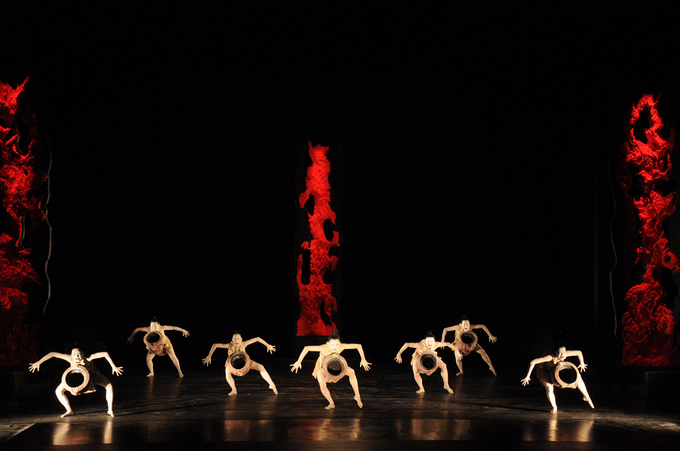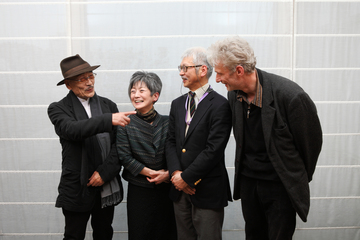Dairakudakan Meets Brazil, the World Meets Butoh
Butoh has influenced a broad range of artistic disciplines including performing arts, literature, fine arts and films. Since the 1970s, Japanese butoh dance companies have received and accepted numerous invitations to perform at international festivals. How has butoh been received by international audiences and what impact has it left on them?
For our discussion about how butoh has been perceived overseas from the 1970s to the present, we have invited Akaji Maro, founder of Dairakudakan and a leading Japanese butoh dancer who performs extensively both at home and abroad and who has just completed his premiere Latin American tour in 2010; Kazuko Kuniyoshi, a dance critic and long-time researcher of butoh; and Patrick de Vos, a professor at the University of Tokyo who specializes in the history of French theater, kabuki, and Japanese physical expressions.
(Moderator: Suichiro Ogino, Performance Arts Section, the Japan Foundation)
Dairakudakan's premiere Latin American tour
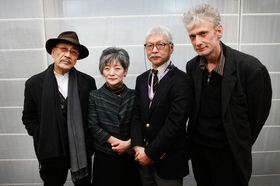 ──Akaji Maro's dance company, Dairakudakan, performed in Mexico and Brazil in autumn 2010, and the tour was a resounding success with all seven shows sold out. The Japan Foundation sponsored the shows in Brazil, which I had the pleasure of organizing. In fact, between 1975 and 1984 I worked on a number of butoh projects with the Japan Foundation, such as the international debut performances of Kazuo Ohno and Dairakudakan, and Tatsumi Hijikata's European premiere. Back in those early days, providing any form of financial assistance to butoh dancers--even footing their airfare bill--was a challenge. Now, butoh has gained so much respect that the Japan Foundation is sponsoring Dairakudakan's international tour. Times have changed, indeed.
──Akaji Maro's dance company, Dairakudakan, performed in Mexico and Brazil in autumn 2010, and the tour was a resounding success with all seven shows sold out. The Japan Foundation sponsored the shows in Brazil, which I had the pleasure of organizing. In fact, between 1975 and 1984 I worked on a number of butoh projects with the Japan Foundation, such as the international debut performances of Kazuo Ohno and Dairakudakan, and Tatsumi Hijikata's European premiere. Back in those early days, providing any form of financial assistance to butoh dancers--even footing their airfare bill--was a challenge. Now, butoh has gained so much respect that the Japan Foundation is sponsoring Dairakudakan's international tour. Times have changed, indeed.
Let me reiterate my congratulations to you, Maro-san, for your successful tour in Latin America. Would you tell us how your shows were received by the audiences in Mexico and Brazil?
MARO: Thank you very much. To tell the truth, I was quite anxious as to how we would be received in Mexico and Brazil, given that this was our first time performing there. But thankfully we had a full house for each performance, and even got standing ovations.
And I asked myself, why all the enthusiasm? Both Mexico and Brazil were European colonies a few hundred years ago. There's a fusion still in progress within their peoples, between traditional Latin American culture and the new culture that was imported from Europe. It hasn't quite solidified yet. Then I showed up out of the blue with something yet completely different, and they went wild with excitement. I might have given them a hint as to the new identity they seek. Or maybe I'm exaggerating.
──Perhaps the Mexicans and Brazilians intuitively understand the dark, even demonic world of your performance. Do audiences and critics react very differently from country to country?
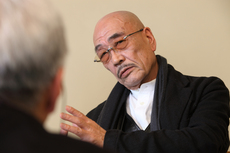 MARO: I would say so, yes. The French, for instance, are familiar with the Japanese culture. So familiar, in fact, that some want to show off they understand it better than we do. Say, for a split second, a gesture I make looks, unconsciously (as I find it distasteful), zen-like or classically Japanese. The French have had enough of that. Some critics attack the anachronism, which, for me, is both annoying and stimulating. In a sense, I cause more international friction than goodwill, but that's part of the fun of performing abroad: meeting the audience halfway.
MARO: I would say so, yes. The French, for instance, are familiar with the Japanese culture. So familiar, in fact, that some want to show off they understand it better than we do. Say, for a split second, a gesture I make looks, unconsciously (as I find it distasteful), zen-like or classically Japanese. The French have had enough of that. Some critics attack the anachronism, which, for me, is both annoying and stimulating. In a sense, I cause more international friction than goodwill, but that's part of the fun of performing abroad: meeting the audience halfway.
In the end, a dancer is a carp on the cutting board--whether the reception is warm or chilly is up to the beholder. When I first performed in the United States, I said, "I didn't bring you dance. I brought you Japan." I thought it sounded cool. A confused The New York Times reporter asked what exactly she was supposed to write, so I told her, "I'm a carp on the cutting board. You cook me any way you like." She ended up illustrating her story with a picture, from the Edo period, of a carp on a cutting board. Really, I'm not kidding.
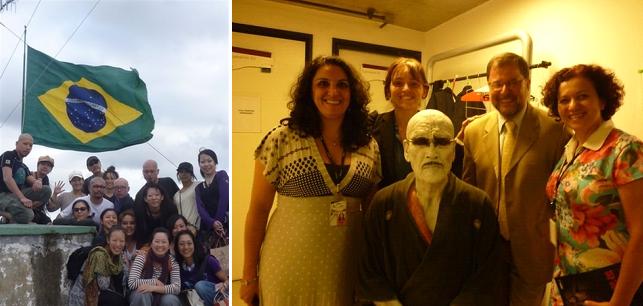
Left: In Santos, Brazil, after a show.
Right: With members of SESC, Brazil's Social Service of Commerce, which helped organize the tour.
Revisiting the history of butoh
──I would like to turn now to Kazuko Kuniyoshi. As a close apprentice of the dance critic Miyabi Ichikawa, who was instrumental in introducing butoh overseas, Kuniyoshi-san has observed numerous butoh pieces since the 1970s. Can you tell us what impact butoh's international success in the 1980s had on the Japanese contemporary dance community?
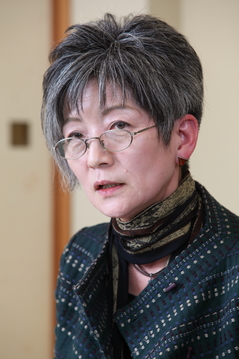 KUNIYOSHI: In the late 1970s, the world of Japanese contemporary dance was represented on the one hand by a group of dancers influenced by American postmodern dance, led by Bonjin Atsugi, and on the other by Tatsumi Hijikata's ankoku-butoh and a number of dancers inspired by it, such as Kazuo Ohno, Akira Kasai and Akaji Maro's troupe. While practitioners of contemporary dance rooted in the prewar era had increased in number, their focus was solely on acquiring Western techniques and synthesizing them into the existing dance form to establish an authentic Japanese modern dance.
KUNIYOSHI: In the late 1970s, the world of Japanese contemporary dance was represented on the one hand by a group of dancers influenced by American postmodern dance, led by Bonjin Atsugi, and on the other by Tatsumi Hijikata's ankoku-butoh and a number of dancers inspired by it, such as Kazuo Ohno, Akira Kasai and Akaji Maro's troupe. While practitioners of contemporary dance rooted in the prewar era had increased in number, their focus was solely on acquiring Western techniques and synthesizing them into the existing dance form to establish an authentic Japanese modern dance.
The advent of butoh should have overturned the conventional awareness of the body as a medium of expression, but the world of contemporary dance wasn't all that keen to understand butoh. Although butoh derives from contemporary dance, it was perceived more as an experimental form of expression in theater or art than as a genre of dance. The world of contemporary dance distanced itself from the anti-establishment, troublemaking butoh, and consequently wasn't influenced too directly by it back then. Butoh was unacknowledged, cast aside and ignored. But this also secured it the freedom to grow outside the proprieties of the world of contemporary dance.
After 1986, when Tatsumi Hijikata passed away and butoh temporarily lost its initial momentum, the so-called forerunners of the current contemporary dance, like Saburo Teshigawara, emerged. This was a period when the mainstream contemporary dance community opted to stay conservative and distance itself from the latest developments, and as a result, it freed artists from the traditional master-apprentice relationship framework and made way for newcomers to break into the dance world. So the foundation of the current dance scene was laid in the late 1970s, and it continued to evolve over the next 20 years or so.
──Indeed, the contemporary dance community did regard butoh with hostility in those days. Yet butoh is highly regarded in recent years. When did this change happen?
KUNIYOSHI: I would say the change had a lot to do with Kazuo Ohno's achievements. It was in the mid-1990s that butoh gained general recognition and acclaim.
Ohno received the Dance Critics' Circle Award in 1994 and again in 1996. He was designated Messenger of the Year by the International Theatre Institute (ITI) in 1998, an honor shared by distinguished figures like Maurice Bejart and Pina Bausch. And he won the Michelangelo Antonioni Award in 1999. So you could say that Ohno's work, and butoh in general, became widely accepted as a respectable art form owing to his receiving awards from these renowned organizations.
Butoh was already starting to attract attention in the West with Ohno's success at the World Theatre Festival in Nancy, France, in 1980. It did not enjoy the same prominence in Japan, however, where butoh remained in obscurity. All that began to change with the Butoh Festival of 1985 sponsored by the Nippon Cultural Centre, which helped the Japanese public to finally take notice that butoh was this amazing form of artistic expression cultivated in postwar Japan. It was even later, in the mid 1990s, that the Japanese came to appreciate that Tatsumi Hijikata's philosophy was having a widespread impact not only on dance but on art in general.
──What are the legacies of these butoh pioneers' works on today's contemporary dance?
KUNIYOSHI: The first thing that comes to mind is the words of Tatsumi Hijikata and Kazuo Ohno. Young artists now interpret those words in their own ways and integrate them into their creations. I think it's wonderful that those words, so powerful and motivating, remain fully intact in print, and that they have had influences far beyond the realm of physical expression and continue to inspire all those who engage in creative work.
──Tatsumi Hijikata and Kazuo Ohno would speak in images, and their conversations were almost like symbolical poetry. I had no idea what they were talking about, but they understood each other perfectly.
KUNIYOSHI: One can only imagine how well Ohno understood Hijikata. Hijikata must have left many inspirational words for you, too, Maro-san.
MARO: His approach to the body--the words he uses to convey it, that is--came from unexpected angles. He would say, "Why do you put your right foot out and then your left foot to walk?" It left me dumbstruck. Or he might say, "If you've nothing else to do, lie down and go to sleep." He was constantly exploring dance not imprinted in Western or Japanese tradition. Once, there was a baby babbling along with some music. He grabbed it and held it high, declaring, "This is dance." That was how his mind worked.
KUNIYOSHI: His view of the body was that you never create it anew but rather discover it. This has become something of a mantra for dancers in quest of new body movements.
Butoh across the ocean
──Now let us turn to you, De Vos-san. You first came to Japan in 1977. What sparked your interest in Japanese theater?
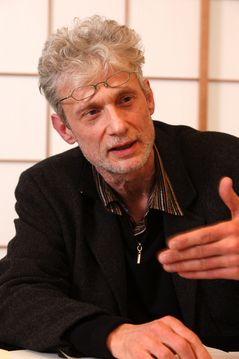 DE VOS: The University of Paris had a Japanese studies department, where I studied mainly Japanese language and literature. My primary interest was philosophy, and I was captivated by the works of Gilles Deleuze, Michel Foucault, and Pierre-Félix Guattari. As I went through their literature, such as Guattari's critique of Min Tanaka, I began to take interest in butoh and Japanese performing arts in general.
DE VOS: The University of Paris had a Japanese studies department, where I studied mainly Japanese language and literature. My primary interest was philosophy, and I was captivated by the works of Gilles Deleuze, Michel Foucault, and Pierre-Félix Guattari. As I went through their literature, such as Guattari's critique of Min Tanaka, I began to take interest in butoh and Japanese performing arts in general.
──The underground theater troupes of Shuji Terayama and Tadashi Suzuki began to enjoy some success in Europe in the early 1970s. Already in the late 1970s, we were starting to hear some French in butoh audiences in Japan. Were there any channels through which the trends of Japanese theater were conveyed to France in those days?
DE VOS: We had several leading avant-garde theaters symbolic of 1970s Paris, so people in their circles must have heard about butoh. Also, a pantomime artist and dancer called Theo Lesoualch spent some time in Japan in the 1960s and 1970s, and he reportedly went to see Tatsumi Hijikata's shows quite often.
MARO: Yes, he was there all the time.
KUNIYOSHI: Theo Lesoualch performed pantomime at Sogetsu Hall (Tokyo) in February 1962. Miyabi Ichikawa mentioned him in his stage critique.
DE VOS: That's right. This Lesoualch later published two books in France: Erotique du Japon and Les rizières du théâtre japonais. They were widely read as the earliest introductions to Japanese theater, and helped create a framework of sorts for accepting and understanding the Japanese culture.
Until then the French perceived Japan as an emerging economy that was overcoming a defeat in the war. But what Lesoualch introduced in his books were progressive, erotic images, like bodies dancing in the middle of a rice field. Of course, Nagisa Oshima and Shuji Terayama were already known before butoh made its appearance in France, so a new image of Japan began to solidify--a Japan that was erotic, sophisticated, and a creator of what you might call the "aesthetics of violence."
──Around the same period, Corinne Bret, a correspondent for the French daily newspaper Liberation, came to see many different theater and dance performances.
DE VOS: Yes, so all these people helped create increasing opportunities for butoh dancers to perform in Paris, particularly after the late 1970s. Kazuo Ohno, Sumako Koseki, Ko Murobushi, and Carlotta Ikeda were among them. That was when I started to show an interest in butoh. So I came to Japan, and I initially intended to write my master's thesis on Takaaki Yoshimoto's Kyodo gensoron (Theory of co-fantasy). But then I began to think I should base my paper on actual pieces of work rather than on theory, and in the end I wrote about my research subject, Kabuki, which I studied under Gunji Masakatsu. Under his guidance I touched on Hijikata's Tohoku Kabuki as well.
MARO: Was it quite usual for students in Paris to take an interest in butoh?
DE VOS: No, not at all! I suppose a lot of students harbored some level of interest in the orient, but it was mostly a superficial infatuation with oriental philosophy, like Zen, that drifted into France as part of the American hippie culture. That was not enough for anyone who sought a deeper understanding of the subject, so it was a matter of natural progression that their interests moved on to theater and other individual artistic works.
Butoh as an antithesis
──When we introduced one of Tatsumi Hijikata's pieces in Europe in 1983, some local critics talked about the work in the context of the atomic bomb or traditional arts. How exactly was butoh viewed in Europe around that time?
DE VOS: That is difficult to answer in a word or two, but I must say it was important that butoh was appreciated by the intellectual community. For example, if Guattari wrote something about butoh or Min Tanaka, it would draw huge attention and actors, dancers and artists, in addition to philosophers, would go and see those works.
MARO: That was how things were back then. Artists often crossed disciplines.
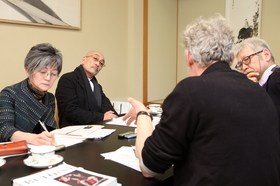 DE VOS: People in different fields had different views of butoh. So it wasn't appreciated in a uniform manner, but in diverse ways. Later on, the Europeans recognized that butoh was not a specifically Japanese aesthetic, and they began to identify it with a number of universal concepts, such as the three I mentioned earlier--eroticism, sophistication and violence.
DE VOS: People in different fields had different views of butoh. So it wasn't appreciated in a uniform manner, but in diverse ways. Later on, the Europeans recognized that butoh was not a specifically Japanese aesthetic, and they began to identify it with a number of universal concepts, such as the three I mentioned earlier--eroticism, sophistication and violence.
Another notable factor that influenced the European view of butoh was, of course, the war, and the nuclear bomb attack on Hiroshima in particular. Theater critic George Banu discussed in his writing why butoh evoked such a strong, emotional response in Westerners. He explained: "It is because Westerners, including Americans, have committed horrible acts against the Japanese, and butoh questions our sense of guilt." This, of course, is strictly Banu's opinion.
Dancers, meanwhile, tended to be more interested in the abstract aspects of butoh. Around 1981, Bernardo Montet and Catherine Diverres came to Japan to study under Kazuo Ohno. I have never seen them perform live, but I could tell from films and photographs that they had gained an understanding of the more internal aspects of butoh, and not just the stereotypical gestures or styles.
──I would imagine that a European country wouldn't invite performing artists from abroad--a costly undertaking--just for promoting international goodwill; there must be something that benefits the host country's cultural industries. So what did butoh offer Europe?
DE VOS: We must understand the state of the French dance community to appreciate why it welcomed butoh with such enthusiasm, just as French intellectuals developed a profound interest in it as early as 1981.
The world of French contemporary dance in the early 1980s was under an overwhelming influence of American post-modern dance. It was typical for young dancers to go to America and spend a few months, or maybe a few years, training at the Merce Cunningham Studio. Many first-generation dancers of nouvelle danse were trained in this way. Then the burgeoning Japanese dance form emerged, presenting an antithesis, a model that was in stark contrast to the prevailing style. It is no coincidence that you could discern influences of butoh and German dance theater on the nouvelle danse of the 1980s.
The scholar Sylviane Pages tried to explain why the Japanese culture played such a significant role in France in the early 1980s. According to Pages, there were two reasons: one, France needed a counterweight to the huge and overwhelming influence of America, and two, it was a reaction to the long detachment from prewar German expressionism. Since the war, France had sought to shut out the influence of Nazi-era German culture, and its attachment to the physical expressions derived from that culture, his theory went, until butoh came along and inadvertently tapped that long dormant link with Germany.
KUNIYOSHI: Miyabi Ichikawa also wrote in his report on the Munich Theater Festival in 1982 that some believed one of the reasons butoh was welcomed in Europe was to get rid of the influence of American dance.
DE VOS: Yes, there was resentment against the rigid formalism and abstract choreography of the American dance style, developed most prominently by Cunningham. So we had America, the holy land of dance, on the one hand, and Japan, its stark opposition, on the other.
MARO: But now that the French have expressed their admiration of butoh, we may get yet another reaction, like, "we can't put up with butoh." A new antithesis against the old antithesis.
KUNIYOSHI: It is very French, that you would need an antithesis in order to move on to the next.
MARO: A reaction against a certain phenomenon is a very natural thing to have. Only butoh isn't so easy to break away from because it has this slimy, ambiguous quality. It's like a swamp. I suppose it has lasted this long precisely because it lacks definite form or shape.
DE VOS:A swamp is a good analogy. In Cunningham's dance, body contours are clearly defined. It's abstract and hard-edged. That makes butoh, with its shabby costumes, wriggly contours and slow, distorted body movements all the more a contrast.
MARO: There is no telling which is the right way to live. Personally, though, I think the slow, twisted movements would help us live longer. You can't go through life trying to look perfect all the time.
Butoh: dance or theater?
KUNIYOSHI:May I ask a quick question before we end this discussion? Did the French view Le Dernier Eden, the first butoh performance in Paris, by Ko Murobushi and Carlotta Ikeda in 1978, as a drama rather than as a dance piece?
DE VOS: Yes, I believe so. Silvia Monfort, where they performed, was a theater that staged dramas. The majority of the audience must have been drama fans.
KUNIYOSHI: Butoh is often regarded as drama. Maro-san's works are also frequently described in reviews as being theatrical.
MARO: I resent that word, theatrical. Pina Bausch's works are usually described along the lines of "transcending the border between dance and theater." But somehow butoh is theatrical. I'm not saying Pina hasn't transcended the border, but I don't like the expression. What is the point of transcending the border, and what does it really mean, anyway?
KUNIYOSHI: If a work cannot be categorized in one discipline or another, then it means it has transcended the border, doesn't it?
MARO: Right. I have nothing against being categorized; it's part of the job. But every form of expression carries with it all kinds of artistic elements. Butoh is a kind of art that takes form when you cast some unexpected words onto a gesture or movement, like that example I mentioned earlier about the babbling baby: someone calls it dance and suddenly you get a completely new perspective. Butoh comes to life when you embellish it with words.
KUNIYOSHI: Here is an interesting example of the idea that words create butoh: In 2008, the choreographer Boris Charmatz created the piece La danseuse malade inspired by Tatsumi Hijikata's literature. Words continue to resonate through time, don't they?
MARO: I heard even the name "butoh" is a mere creation, by Akira Kasai. No doubt butoh is something alien and hazy. It takes shape when you give it words, but the next moment it changes shape and slips away, like amoeba. It's an anti-thing.
──There is so much more to talk about on this subject but I would like to conclude our discussion now. Today, we were able to have an in-depth discussion about the reception of butoh abroad, revolving around the story of Maro-san's Latin American tour. They say the light of Japonism ignited in 19th century Europe continued to burn for half a century, and now, the feverish interest in butoh overseas has gone on for nearly 40 years. The fascination never seems to wane; it keeps growing. It is important that we keep the torch lit and hand it over to the next generation, and to that end, I wish you success in your respective fields. Thank you for taking part in this discussion today.
Akaji Maro
Founder of Dairakudakan; born in Nara Prefecture in 1943. After a period of activity in the theater company Budo no kai, he studied under butoh pioneer Tatsumi Hijikata. In 1964 Maro established Jokyo Gekijyo, an underground theater troupe, with Juro Kara, whose "privileged body" theory he manifested in his performance. After launching Dairakudakan in 1972, he starred in many films and TV programs including those produced by Nagisa Oshima, Seijun Suzuki and Quentin Tarantino. He received the Dance Critics' Circle Award in 1974, 1987, 1996, 1999, and 2008, and the Commissioner for Cultural Affairs Award in 2006.
Dairakudakan
Butoh dance company established in 1972 by Akaji Maro. It performs in a unique dance style Maro developed and named Temputenshiki (meaning "being born into the world is a great talent in itself"). The company has collected and incorporated forgotten miburi-teburi (gestures) into its dance form and has performed over 60 pieces of work.
Dairakudakan made its overseas debut in France and the U.S. in 1982, and its tour of 34 cities in 12 countries thereafter became instrumental in spreading butoh around the world. The company holds regular performances (dubbed the "Kochuten series") at its own Kochuten studio located in western Tokyo.
In 2009 Akaji Maro presented two of his latest productions at theaters in Tokyo: Symphony M at Setagaya Public Theater in February and G wa iku at Setagaya Theater Tram in October. Maro toured Mexico and Brazil in October 2010, and performed the Temputenshiki-style program Ash Man, which marked the 39th anniversary of Dairakudakan, in Setagaya Public Theater in March 2011. He received Dance Critics' Circle Award in 1974, 1987, 1996, 1999, and 2008.
Kazuko Kuniyoshi
Dance researcher and critic; visiting professor at Tama Art University and part-time instructor at Rikkyo University and Waseda University; director of the Japanese Society for Dance Research; the secretariat of Nihon Youbushi Kenkyukai (Japanese society for research of Western dance history) and leader of Maihime no kai (Tatsumi Hijikata research group); and judge of the Toyota Choreography Award (2002-2004). Author of Yume no ishou, kioku no tsubo--Butoh to modernism (Costume of dreams, vase of memories--Butoh and modernism); co-editor of Nihon youbushi nempyou I-VI (History of Western dance in Japan I-VI); and editor of Miru koto no kyori--Dansu no kiseki 1962-1996 (The distance of observing--History of dance 1962-1996), a collection of writings by Miyabi Ichikawa.
Suichiro Ogino
Joined the Japan Foundation in 1972 and worked in Tokyo, Kyoto, Rome and Toronto. Since his retirement in 2009, Ogino has worked part-time in the Performing Arts Section of the Japan Foundation. Author of "What is internationalism?" (Japan Foundation magazine Kokusai Koryu, May 1983 issue) and "Reviewing the European awareness--Reactions to ankoku-butoh performance" (Bijutsu Techo, November 1983 issue, Bijutsu Shuppan); co-editor of "Le buto et ses fantomes" (Alternatives theatrales, No. 22-23 (April-May 1985)).
Patrick De Vos
Professor at the Graduate School of Arts and Sciences, the University of Tokyo, specializing in French theater and performing arts theory. De Vos takes interest in a wide range of fields, from classic theater to 20th century performing arts. His research topics include works up to the present that question modernity in French theater history, theatrical theories and critiques, bodily expressions in Japanese classical theater, and Japanese dance developed after the 1960s, particularly butoh and its global evolution.
Related Events
Keywords
- Dance
- Traditional Arts
- Theater
- Arts/Contemporary Arts
- Music
- History
- Japanese Studies
- Japan
- Mexico
- Brazil
- France
- Butoh
- Akaji Maro
- Dairakudakan
- Kazuko Kuniyoshi
- Patrick De Vos
- Brazil
- Kazuo Ohno
- Tatsumi Hijikata
- Miyabi Ichikawa
- Bonjin Atsugi
- Akira Kasai
- Saburo Teshigawara
- Maurice Bejart
- Pina Bausch
- Michelangelo Antonioni Award
- World Theatre Festival in Nancy
- Shuji Terayama
- Tadashi Suzuki
- Theo Lesoualch
- Nagisa Oshima
- Sumako Koseki
- Ko Murobushi
- Akira Kasai
- erotic
- history of French theater
- Carlotta Ikeda
- Takaaki Yoshimoto
- Gunji Masakatsu
- nouvelle danse
- Sylviane Pages
- The Japan Foundation Sao Paulo
Back Issues
- 2025.6. 9 Creating a World Tog…
- 2024.10.25 My Life in Japan, Li…
- 2024.5.24 The 50th Japan Found…
- 2024.5.24 The 50th Japan Found…
- 2024.5. 2 People-to-People Exc…
- 2024.5. 2 People-to-People Exc…
- 2023.12. 7 Movie Theaters aroun…
- 2023.6.16 The 49th Japan Found…
- 2023.4.24 The 49th Japan Found…
- 2022.12.27 Living Together with…


